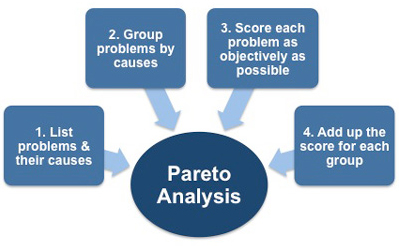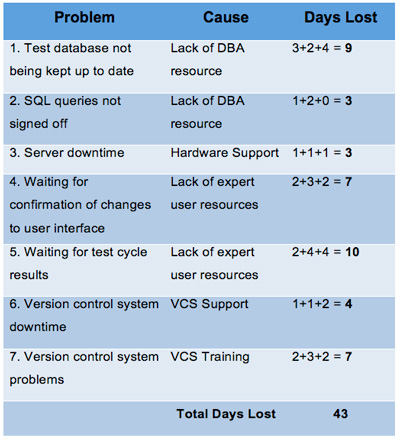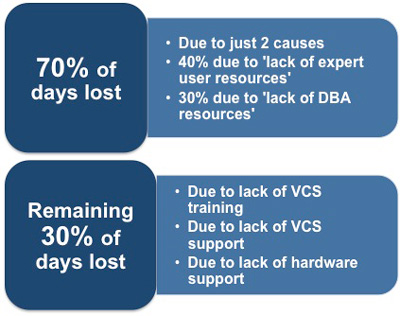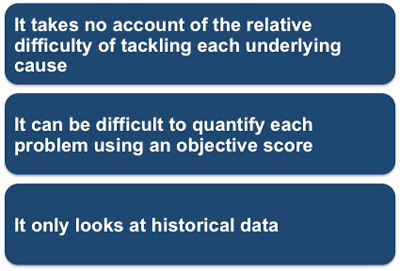Time Management - Pareto Analysis
The Italian economist Vilfredo Pareto discovered that within any system the tendency is for some elements to yield much higher returns than others. Usually, around 20% of the elements will be high yielders and the remaining 80% will be low yielders.
What is even more interesting is that the 20% of high yielders tend to produce around 80% of the yield and the 80% of low yielders produce the remaining 20%.
Whilst Pareto's research was concerned with economics and found, for example, that 20% of an organization's customers are responsible for 80% of its profits, the 80/20 principle has been found to apply to a wide variety of areas.
 |
The figures 80 and 20 are illustrative - the Pareto Principle illustrates the lack of symmetry that often appears between two related factors. For example, 10% of your clients could generate 90% of the complaints you have to deal with, or 75% of your suppliers may be responsible for only 25% of your inventory.
In terms of time management and productivity, it implies that 20% of the time that you spend on something will produce 80% of your final output, while the remaining 80% of your time will produce only 20% of it. The Pareto Analysis is a useful technique for prioritizing problem-solving work, enabling you to ensure that the first piece of work you complete also resolves the greatest number of problems.
There are 4 steps in performing a Pareto Analysis:
 |
This exercise not only shows you the most important underlying cause, it also gives you a numerical score, allowing you to compare the severity of the problems caused by it.
Image a scenario where you are the IT manager and you have been given responsibility for turning around a strategic business project that is running behind schedule. Your first action is to interview all of the team leaders involved and ask them to explain how their part of the project has been performing, highlighting any areas that have fallen behind and to provide valid reasons for this, whilst quantifying the number of days lost in each case.
From this exercise you obtain the following data:
 |
This table clearly shows you what has caused days to be lost on the project and highlights which of these causes have accounted for the greatest disruption.
 |
You can clearly see that 'lack of' in both expert users and DBA resources is the key issue you need to address with some urgency to get your project back on track.
Whilst using Pareto Analysis can be helpful in aiding your decisions about what priority to set each task, it does have certain limitations, which you must factor into your decision-making process:
• No account is taken of the relative difficulty of dealing with each underlying cause.
• Each problem is difficulty to quantify with an objective score.
• Only historical data is taken into consideration.
 |
When you take into account how these limitations could influence your ability to resolve the cause of lost days in our example, you will appreciate the practicalities of using this method of analysis.
• It takes no account of the relative difficulty of tackling each underlying cause.
In the above example, 70% of the days lost are caused by two resource issues. Your ability to tackle each of these causes will vary, as one is under your direct control and the other is not.
You might be able to address the lack of DBA resource with a single phone call, as these are all under the direct control of the IT project manager who reports to you.
This is also likely to be applicable for the more minor causes of lost days of VCS Training, VCS Support, and Hardware Support problems. A single call to the relevant department or management colleague will ensure training is organized and the necessary support levels are increased.
When you look at the best way to address the major cause of lost days (being in this case the lack of expert user resource), this is not an area you have any direct authority over as it is due to the actual users themselves and is not an IT issue per se. It could also be an intractable problem due to long-term illness or a chronic lack of resources in the relevant user department.
Therefore, in order to bring the project back on schedule, your priority is to address the first issue of lack of DBA resources with a single phone call. This enables you to achieve the greatest gain for the least effort.
The lack of expert user resources will require more of your time and budget to address satisfactorily and to resolve this issue for the project to run successfully.
• It can be difficult to quantify each problem using an objective score
Asking each of the team leaders to provide a figure for the number of days lost because of each problem appears to be an objective measure, but how much faith can you really place in their answers? They may be tempted to blame external factors rather than issues that they themselves are responsible for.
The quality of the Pareto Analysis will always be dependent on the reliability of the scores that you assign to each problem.
• It only looks at historical data
The lack of expert user resources has led to the loss of 17 days so far. However, it is possible that this resource will become less important as the project progresses. In fact it may not be required at all.
The assumption implicit in the Pareto Analysis is that the system you are trying to fix is constant through time. This may or may not be true.
Each of these limitations means that you will need to exercise careful judgment when using the Pareto Analysis method.
You may also be interested in:
Time Management Productivity Tools | Urgency/Importance Grid | ABC Analysis | Reverse Schedule | Closed To Do List | Calendar Tools | To Do List Tools | Launcher and HotKey Tools | Monitoring Tools | Productivity Tools.



